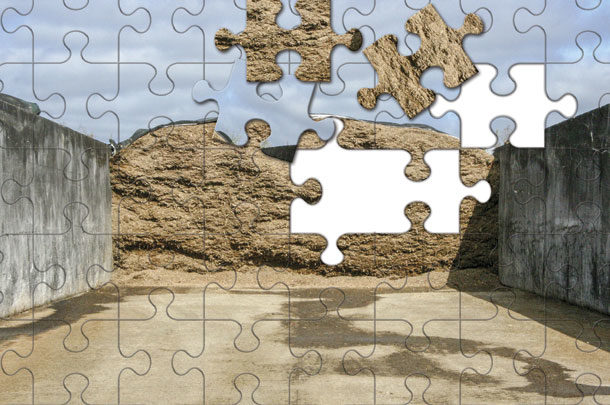By increasing the quality of your forage and reducing shrinkage, considerable cost savings can be achieved without even leaving the farm.
Making silage is much like piecing a puzzle together, and there are many pieces to the silage puzzle, so it can be difficult. Key factors include making sure forages are harvested at the correct maturity and moisture, proper packing, excluding oxygen and managing the face at feedout.
In terms of top spoilage, all these areas can be a factor, with packing density and excluding oxygen being most important.
Seed quality
Focus on quality from the start. When selecting seeds, yield potential, digestibility and grain content are all important factors. Be sure to consult with your seed representative to determine what’s best for your farm.
Moisture and maturity
When it comes time to chop, ensure crops are at the proper moisture and maturity to optimize benefit for the animals. For corn silage, the proper moisture is approximately 65 to 68 percent.
If silage is chopped when the moisture content is too high, there could be dry matter losses, protein degradation, high butyric acid concentrations and reduced palatability.
On the other hand, if silage is chopped when the moisture content is too low, there is the risk of reduced packing potential and reduced density, which can lead to increased spoilage, increased mold growth and mycotoxins.
Mold
Molds like penicillium, aspergillus and fusarium are often found in corn silage and are common mycotoxin producers.
Colourations can help us identify molds, especially in corn silage. White-to-red/pinkish molds are fusarium or field-borne molds. Blue-green molds are typically penicillium, which is more often storage-related but can occur in the field under certain weather conditions. Aspergillus, very common in dry climates, is olive green to yellow in colour.
Many molds cause health issues to both animals and humans, and they can also produce a fair number of different mycotoxins, so be aware and do not touch, inhale, grab or sample those areas.
In humans and animals, penicillium mold alone can cause dermal irritation as well as gut health complications if ingested. Mycotoxins can also cause performance and reproductive problems.
Chop length
For corn silage, the normal chop length should be 6 inches. The quality and digestibility of corn silage can increase with a chop length of 12 to 16 inches, but it is important to remember that 7 to 15 percent of yield could be lost by chopping at that height.
Storage and filling
Proper packing and preservation of forages is very important. High-horsepower, self-propelled choppers and custom operators can increase the rate and speed used to fill silage piles. Remember to fill gradually and in layers of 6 inches or less. Don’t wait until the end to pack it down with the tractor, as the quality of the silage on the top will be significantly decreased.
Silage shrink
The largest amount of shrink and reduction in quality tends to occur at the top of the silage pile. This part of the pile is the worst in terms of packing density. It is also exposed to the most oxygen, allowing it to easily penetrate the silage, creating an environment for molds and yeast to replicate, which will lead to deteriorated silage (or top spoilage).
Generally, top spoilage represents about one-third of what was once good silage. For example, 4 inches of top spoilage was originally 12 inches or 1 foot of quality silage. It is best not to feed the spoiled portion of silage in order to minimize the risk of costly health and production challenges. This part of the pile, therefore, should be a major focus in terms of management.
Higher-quality silage with lower shrink will benefit your bottom line. Given that silage is a major component of the cow’s diet and impacts the types and amounts of other ingredients in the diet, taking steps to improve silage management practices and specifically focusing on reducing top spoilage can have a big impact on reducing silage shrink and improving quality.
There is a lot of money invested in putting up silage, so it is crucial to make sure it is put up correctly to minimize shrink, retain nutrients and ultimately, preserve that investment.
Facing
Increased surface area permits more oxygen to penetrate the feed, triggering mold and yeast growth, which increases heating. Look for a smooth face, with little loose material at the base and edges. Proper facing and feedout equipment can help reduce shrinkage.
A shaver provides a very smooth and clean face and can help reduce losses with proper management. Rakes or claws will cause tine marks, increasing surface area, but they do limit oxygen penetration during facing. Avoid bucket facing, as it leads to a lot of oxygen penetration due to lifting the pile face.
Feeding
After harvest and when storing feed, be patient as to when you are going to feed that silage. There are times when we need to feed before we would like to, but try to keep silage covered for at least four to six weeks before opening the pile or bunker to ensure fermentation is completed and there is stable feed to provide to the herd. If possible, allow three to four months prior to opening silage piles or bunkers to ensure quality feed for your animals.
These are important pieces to the silage puzzle to remember for a year-round approach to silage management. Silage prepared this year will be a key ingredient for next year’s feeding program, and there are long-range consequences, both good and bad.
Issues with silage preparation this year can lead to a year of poor forage quality, while a year of exceptional weather and silage management can result in a year of quality feed and optimal herd health. ![]()
PHOTO: There are several important pieces to the silage puzzle to remember for a year-round approach to silage management. Photo illustration by Carrie Stockebrand.
Pat Crowley is a forage specialist with Alltech. Email Pat Crowley.









